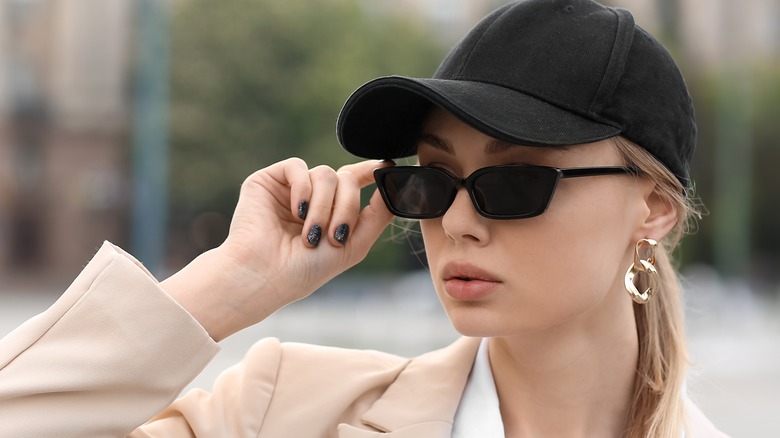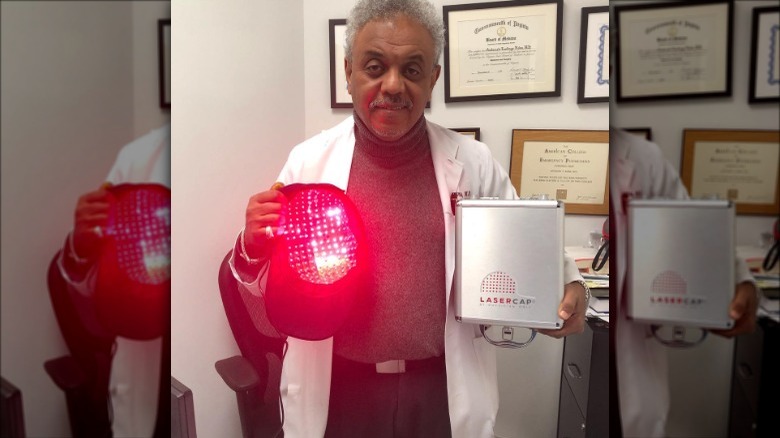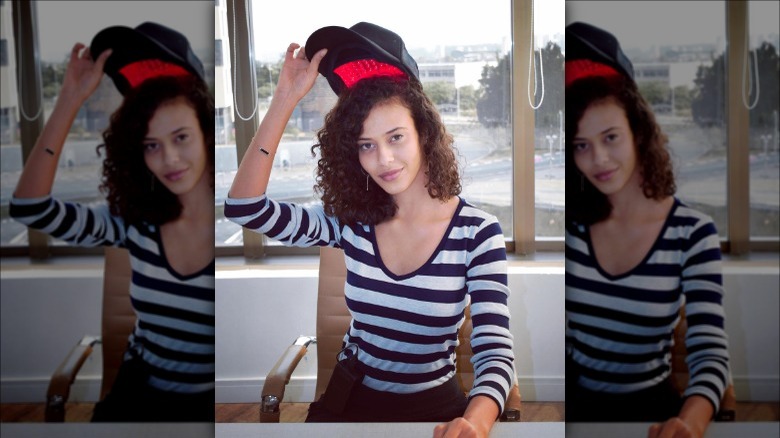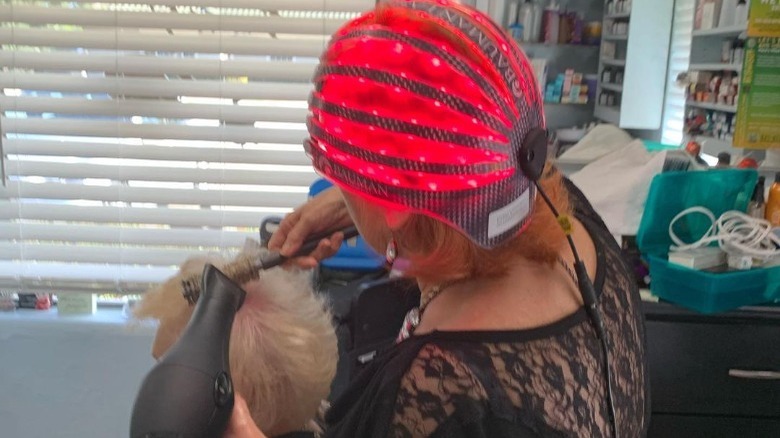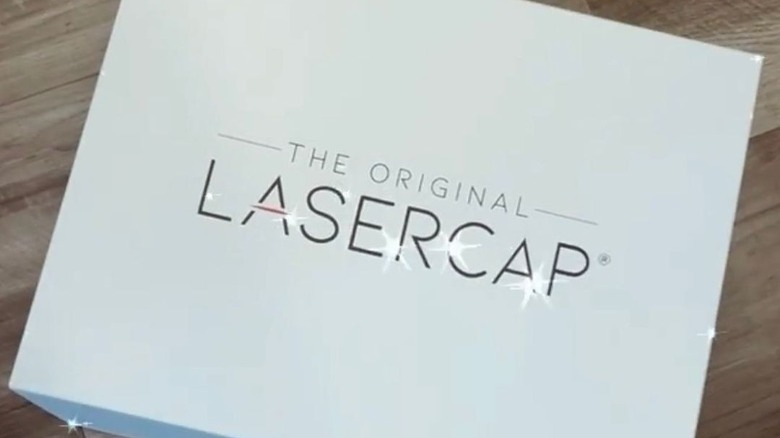What's A Laser Hair Cap And Do They Really Work?
For ages, having a full head of long, voluminous tresses has been viewed as a traditionally feminine trait in many cultures. In a field study published in the Scandinavian Journal of Psychology in 2015, researchers observed that men responded more to female strangers with shoulder-length hair than to women with shorter hair. Now, hair length shouldn't have anything to do with a woman's self-confidence; many women go for the chop when they want to change things up. However, hair loss that occurs against a woman's will — particularly on the exposed parts in the front — can slash a woman's self-image and confidence like nothing else. And hair loss for women can be quite common.
A study published in the Journal of the American Academy of Dermatology reveals that approximately 40% of the female population experience female pattern hair loss — or androgenetic alopecia — by age 50. Hair loss can result from various factors, including aging, genetics, stress, and medications. Dealing with thinning hair and hair loss can be a struggle. But the good news is most hair loss conditions can improve with medical treatments and surgeries. Another treatment that has been touted as the most recent breakthrough in hair loss therapy is laser hair cap — a hair growth-stimulating device safe for home use. What's exciting about it is that it can double up as an accessory, giving you an air of cool that's hard to miss. Here's what to know about a laser hair cap — a shoo-in for your wardrobe's newest flex.
What is laser hair cap, exactly?
According to Torkian Facial Plastic Surgery, a laser hair cap is fundamentally a low-level laser therapy (LLLT) which, when worn over your head, emits red light directly to your scalp to encourage cell growth and regenerate hair follicles. As noted in a study published in the International Journal of Trichology, when the emitted photons penetrate the scalp, they stimulate adenosine triphosphate production in dormant hair follicles, jolting them out of the resting phase and into the growth phase to facilitate hair growth.
The absorption of the laser light into the hair follicle also increases microcirculation, enabling the hair to linger in the growing phase for longer and preventing hair shedding. The treatment is completely pain-free, user-friendly, and usually lasts for about half an hour on average. Laser hair caps are available in a variety of fashionable forms, such as helmets, baseball caps, and headbands. To the average eye, the cap can look just like any regular baseball hat, when in reality, it's radiating energy and supercharging your scalp.
According to the New Jersey Hair Restoration Center, laser hair caps have earned the FDA approval as a laser phototherapy device for treatment of hair loss and stimulation of new, thicker hair growth. Studies suggest that they can treat androgenetic alopecia, a common form of hair loss.
Laser hair caps don't work for everyone
The verdict is still out on whether a laser hair cap — or the LLLT in general — is really effective in stimulating hair regrowth and preventing hair loss. Having said that, LLLT has been shown to improve the hair's volume in various studies. For instance, a study in the journal Lasers in Medical Science associates low-level laser therapy with increased hair regrowth among patients with different degrees of baldness. However, those who have experienced baldness for many years might not find laser hair caps very helpful.
According to the Farjo Hair Institute, laser hair caps only have effects on active hair follicles. They cannot re-energize dead hair follicles or encourage hair growth on the spots where there are no hair follicles to stimulate. No medication can fully reverse hair loss, especially when it is inherited. However, regular use of laser caps and other non-surgical hair restoration techniques might be helpful in slowing down the rate of hair loss. Other approaches, such hair transplant surgery, may be more effective for those at more advanced stages of hair loss. If you're experiencing early-stage hair fall or partial hair loss, it's wise to start using a laser hair cap as soon as possible to prevent further hair fall and reap maximum hair restoration benefits from the technology.
How often you should use a laser hair cap
In a 2020 study published in the journal Skin Appendage Disorders, a group of 141 patients with female pattern hair loss use LLLT-powered combs on their hair three times per week. After 26 weeks, these patients reported major improvement in their hair density. Another study published in the journal Lasers in Medical Science in 2018 also lends support to the effectiveness of laser-based headgear in preventing and reversing hair loss. In this randomized study involving 36 individuals experiencing different degrees of baldness, a group of subjects were instructed to wear laser-based helmets for 20 minutes three times per week. After 24 weeks, those using the laser-based therapy experienced significant improvement in hair regrowth without any side effects.
It would seem that the conventional wisdom is to wear a laser hair cap for 20 minutes three days per week. However, the frequency and length of laser hair cap usage might vary from person to person depending on their hair loss conditions. It's best to consult a dermatologist before using one, as there are different recommendations regarding wear time. For instance, The Knudsen Clinic suggests using a laser hair cap for up to 45 minutes for three days a week.
A laser hair cap can be expensive
FDA-backed laser caps that deliver extensive scalp restoration can cost a bomb. The cost can range from $400 to $3,000 depending on the type of device, light energy, and design. For instance, The Original LaserCap sells a variety of clinical-strength laser hair caps starting from $1,195. At Capillus, you'll also find plenty of physician-recommended options that reflect the newest laser therapy base model, ranging anywhere between $879.20 and $2,399.20. HairMax — one of the oldest names in hair loss treatment products — also serves up a good collection of LLLT headgear starting at $899.
It is advisable to consult a dermatologist or hair specialist before making any purchases, as they can provide you with an accurate diagnosis and guidance on the treatments that will be most effective for you. Investing in a laser hair cap will be a massive waste of money if your hair loss condition requires a more sophisticated treatment, such as a hair transplant. Given the high cost of laser hair caps, it is important to thoroughly review any warranties and fine print before making a purchase to make sure that the manufacturer will offer a replacement or refund if the item is defective. To set realistic expectations, you might also wish to check out consumer reviews and see if anyone experiences less hair shedding or more hair growth after using the product.
The laser cap can work with other treatments
When it comes to dealing with hair loss, two treatments might be better than one. According to Honest Hair Restoration, it can be a good idea to combine a laser hair cap — or any other form of LLLT — with other hair loss treatments to achieve optimal results. You can opt to combine laser cap therapy with additional therapies that have proven effective in treating hair loss, such as exosomal injections.
Injections of platelet-rich plasma (PRP) can also be used in tandem with laser hair caps. PRP works by activating dormant hair follicles into an active growth phase, while LLLT can promote cell functions at the molecular level of the hair follicles to improve the quality and pace of hair growth. According to Charles Medical Group, for those who've gone through a hair transplant procedure, LLLT can also be used to increase blood circulation and speed up the healing process.
Another effective combination in the management of hair loss is a laser hair cap and topical minoxidil. It has been demonstrated that using LLLT and 5% minoxidil together significantly improves hair growth and delays balding. According to a 2021 study published in the Journal of Cutaneous and Aesthetic Surgery, combining LLLT with topical minoxidil and oral finasteride can significantly enhance hair density in people with androgenetic alopecia.
